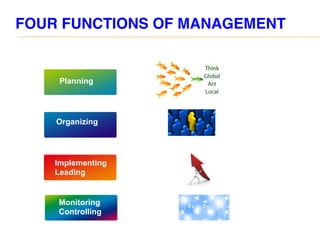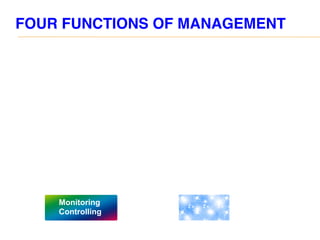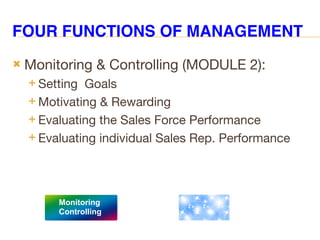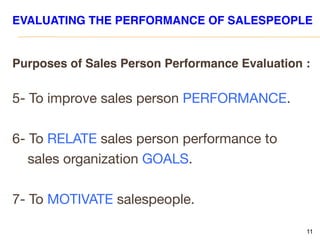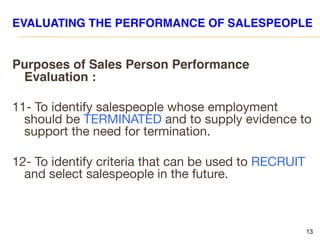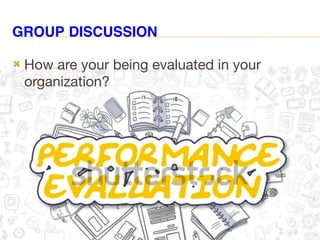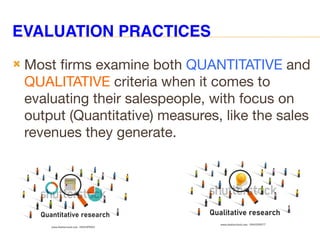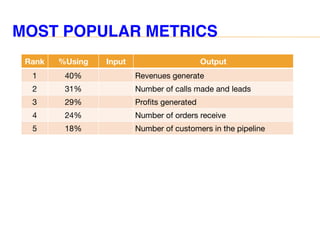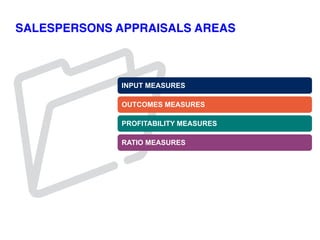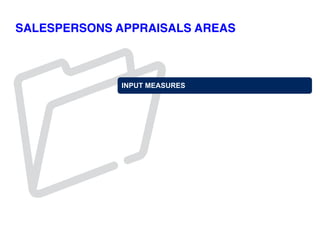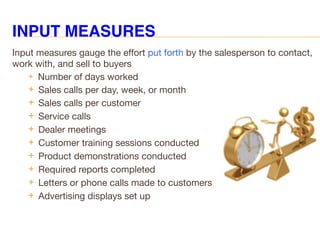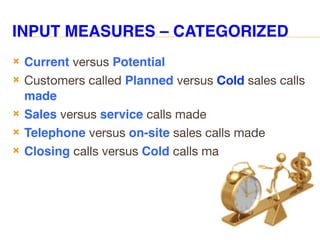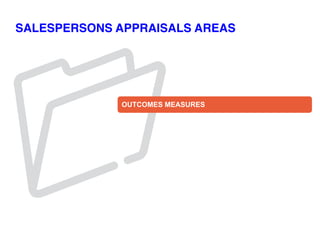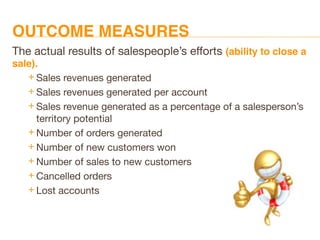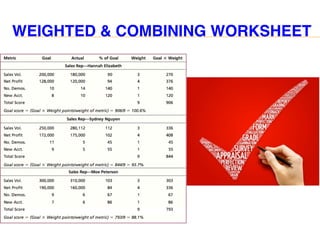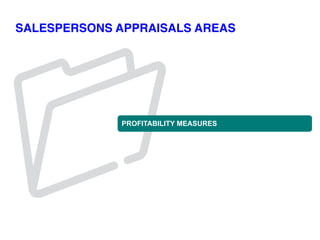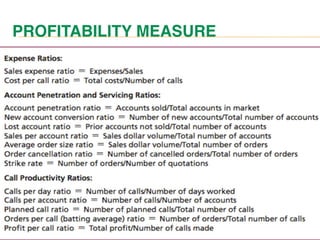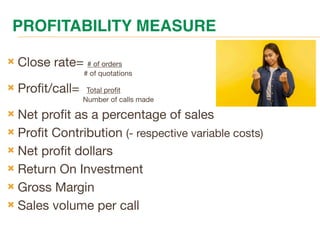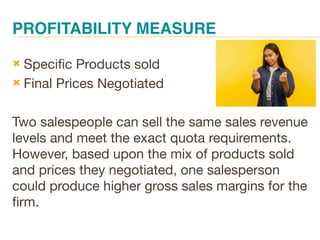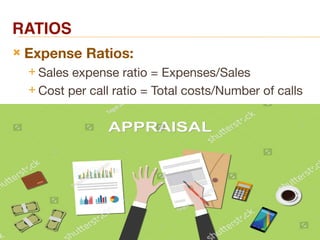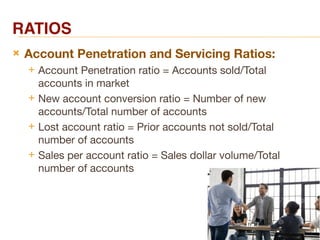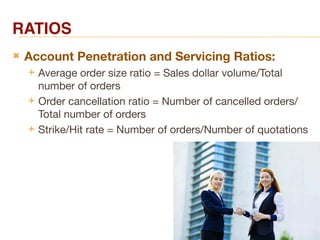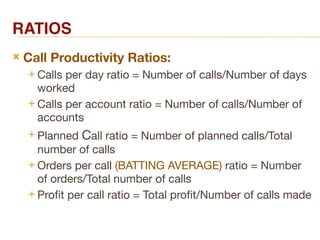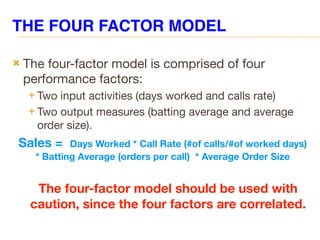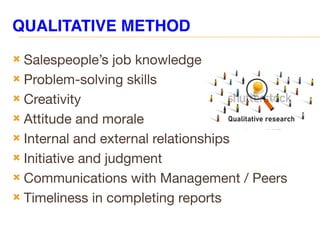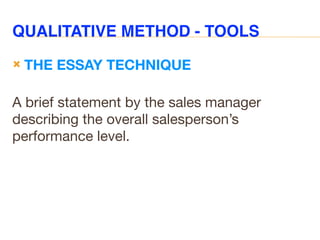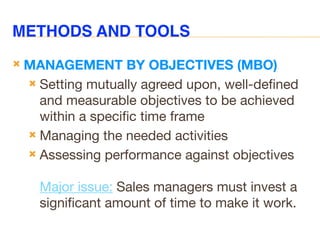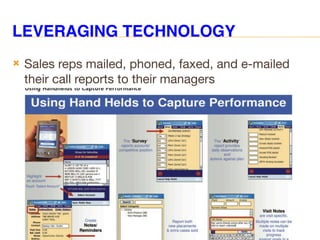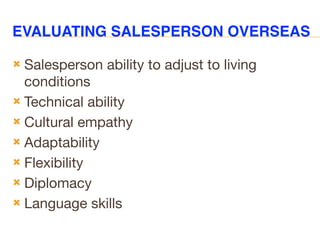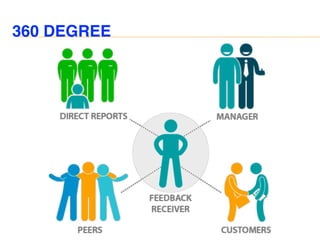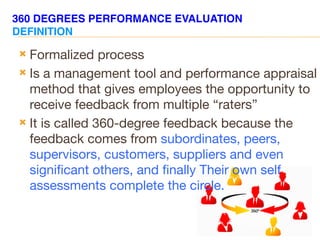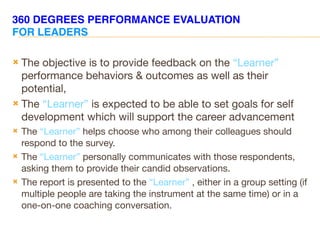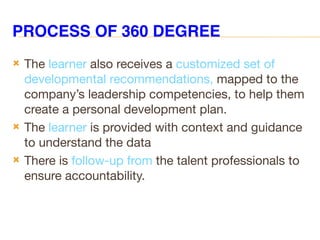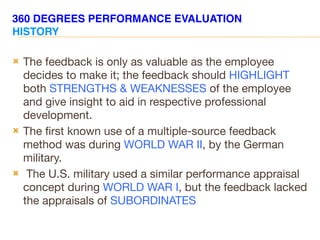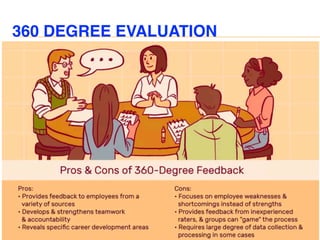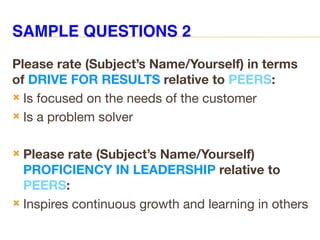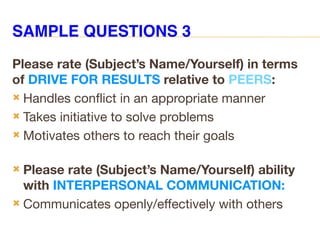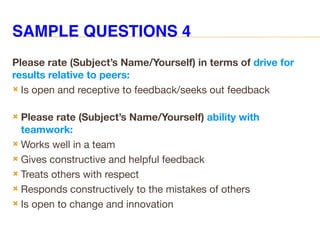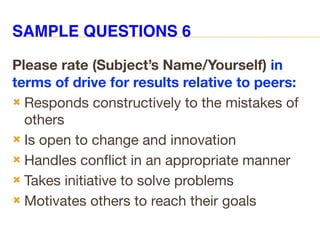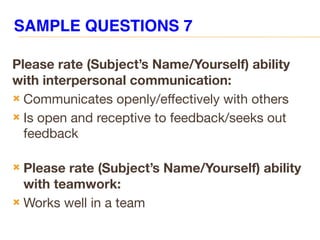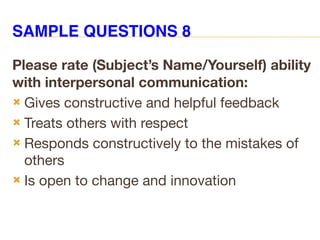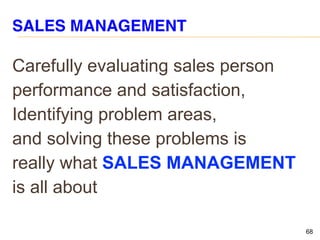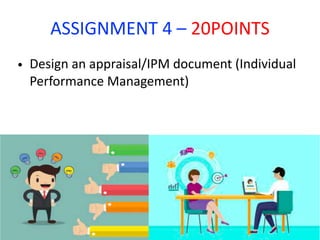Sales MGMt Fall2023 SESSION7_Evaluation IndividualsDS.pdf
- 1. Spring 2023 FUNDAMENTALS OF SALES MANAGEMENT Dina El-Shenawi Sales & Marketing Consultant
- 2. MODULE TWO ŌĆō SESSION 7 EVALUATING PERFORMANCE OF SALES PEOPLE
- 3. FOUR FUNCTIONS OF MANAGEMENT Planning Organizing Implementing Leading Monitoring Controlling
- 4. FOUR FUNCTIONS OF MANAGEMENT Monitoring Controlling
- 5. FOUR FUNCTIONS OF MANAGEMENT ’āÆ Monitoring & Controlling (MODULE 2): ’āē Setting Goals ’āē Motivating & Rewarding ’āē Evaluating the Sales Force Performance ’āē Evaluating individual Sales Rep. Performance Monitoring Controlling
- 6. FOUR FUNCTIONS OF MANAGEMENT ’āÆ Monitoring & Controlling (MODULE 2): ’āē Setting goals ’āē Motivating & Rewarding ’āē Evaluating the Sales Force Performance Ō£Ģ Explain the importance of evaluating OVERALL performance. Ō£Ģ List the advantages and disadvantages of SALES, COST, and PROFIT ANALYSES. Ō£Ģ Understand the importance of profitability and the application of ROI and ROAM. Ō£Ģ Explain the productivity method of evaluation ’āē Evaluating individual Sales Rep. Performance
- 7. FOUR FUNCTIONS OF MANAGEMENT ’āÆ Monitoring & Controlling (MODULE 2): ’āē Setting goals ’āē Motivating & Rewarding ’āē Evaluating the Sales force performance ’āē Evaluating individual Sales rep. performance Monitoring Controlling
- 8. WHY ????
- 9. 9 EVALUATING THE PERFORMANCE OF SALESPEOPLE Purposes of Individual Performance Evaluation : 1- To insure that compensation and other REWARDS are FAIR consistent with actual salesŌĆÖ person performance. 2- To determine the specific TRAINING and counseling needs of individual salespeople and the overall sales force.
- 10. 10 EVALUATING THE PERFORMANCE OF SALESPEOPLE Purposes of Sales Person Performance Evaluation : 3- To provide information for effective HUMAN RESOURCE planning. 4- To enhance COMMUNICATIONS between sales person and sales manager.
- 11. 11 EVALUATING THE PERFORMANCE OF SALESPEOPLE Purposes of Sales Person Performance Evaluation : 5- To improve sales person PERFORMANCE. 6- To RELATE sales person performance to sales organization GOALS. 7- To MOTIVATE salespeople.
- 12. 12 EVALUATING THE PERFORMANCE OF SALESPEOPLE Purposes of Sales Person Performance Evaluation : 8- To help salespeople set CAREER goals. 9- To advise salespeople of work EXPECTATIONS. 10- To identify salespeople who might be PROMOTED.
- 13. 13 EVALUATING THE PERFORMANCE OF SALESPEOPLE Purposes of Sales Person Performance Evaluation : 11- To identify salespeople whose employment should be TERMINATED and to supply evidence to support the need for termination. 12- To identify criteria that can be used to RECRUIT and select salespeople in the future.
- 14. GROUP DISCUSSION ’āÆ How are your being evaluated in your organization?
- 15. EVALUATION PRACTICES ’āÆ Most firms examine both QUANTITATIVE and QUALITATIVE criteria when it comes to evaluating their salespeople, with focus on output (Quantitative) measures, like the sales revenues they generate.
- 16. EVALUATION PRACTICES ’āÆ The input of salespeople is sought, to varying degrees, before their quotas or performance standards are set. ’āÆ The sales goals of different salespeople differ based upon their activities and territories. ’āÆ Companies utilize multiple information sources to perform evaluations. ’āÆ Most salespeople receive a written evaluation conducted in an office setting.
- 17. MOST POPULAR METRICS Rank %Using Input Output 1 40% Revenues generate 2 31% Number of calls made and leads 3 29% Profits generated 4 24% Number of orders receive 5 18% Number of customers in the pipeline
- 19. SALESPERSONS APPRAISALS AREAS PROFITABILITY MEASURES RATIO MEASURES OUTCOMES MEASURES INPUT MEASURES
- 20. SALESPERSONS APPRAISALS AREAS INPUT MEASURES
- 21. INPUT MEASURES Input measures gauge the effort put forth by the salesperson to contact, work with, and sell to buyers ’āē Number of days worked ’āē Sales calls per day, week, or month ’āē Sales calls per customer ’āē Service calls ’āē Dealer meetings ’āē Customer training sessions conducted ’āē Product demonstrations conducted ’āē Required reports completed ’āē Letters or phone calls made to customers ’āē Advertising displays set up
- 22. INPUT MEASURES ŌĆō CATEGORIZED ’āÆ Current versus Potential ’āÆ Customers called Planned versus Cold sales calls made ’āÆ Sales versus service calls made ’āÆ Telephone versus on-site sales calls made ’āÆ Closing calls versus Cold calls made
- 23. SALESPERSONS APPRAISALS AREAS OUTCOMES MEASURES
- 24. OUTCOME MEASURES The actual results of salespeopleŌĆÖs efforts (ability to close a sale). ’āē Sales revenues generated ’āē Sales revenues generated per account ’āē Sales revenue generated as a percentage of a salespersonŌĆÖs territory potential ’āē Number of orders generated ’āē Number of new customers won ’āē Number of sales to new customers ’āē Cancelled orders ’āē Lost accounts
- 25. OUTCOME MEASURES ŌĆō EXAMPLE USA
- 26. WEIGHTED & COMBINING WORKSHEET
- 27. SALESPERSONS APPRAISALS AREAS PROFITABILITY MEASURES
- 29. PROFITABILITY MEASURE ’āÆ Close rate= # of orders # of quotations ’āÆ Profit/call= Total profit Number of calls made ’āÆ Net profit as a percentage of sales ’āÆ Profit Contribution (- respective variable costs) ’āÆ Net profit dollars ’āÆ Return On Investment ’āÆ Gross Margin ’āÆ Sales volume per call
- 30. PROFITABILITY MEASURE ’āÆ Specific Products sold ’āÆ Final Prices Negotiated Two salespeople can sell the same sales revenue levels and meet the exact quota requirements. However, based upon the mix of products sold and prices they negotiated, one salesperson could produce higher gross sales margins for the firm.
- 31. PROFITABILITY MEASURE ’āÆ Likewise, expenses salespeople accumulate, to improve their firmŌĆÖs profitability, ’āÆ Profitability criteria are, in fact, increasingly being incorporated into salespeopleŌĆÖs assessments and can directly impact a salespersonŌĆÖs quota and bonuses. ’āÆ During times of slow growth and heavy competition, Profitability is critically important to firms.
- 32. SALESPERSONS APPRAISALS AREAS RATIO MEASURES
- 33. RATIOS ’āÆ Expense Ratios: ’āē Sales expense ratio = Expenses/Sales ’āē Cost per call ratio = Total costs/Number of calls
- 34. RATIOS ’āÆ Account Penetration and Servicing Ratios: ’āē Account Penetration ratio = Accounts sold/Total accounts in market ’āē New account conversion ratio = Number of new accounts/Total number of accounts ’āē Lost account ratio = Prior accounts not sold/Total number of accounts ’āē Sales per account ratio = Sales dollar volume/Total number of accounts
- 35. RATIOS ’āÆ Account Penetration and Servicing Ratios: ’āē Average order size ratio = Sales dollar volume/Total number of orders ’āē Order cancellation ratio = Number of cancelled orders/ Total number of orders ’āē Strike/Hit rate = Number of orders/Number of quotations
- 36. RATIOS ’āÆ Call Productivity Ratios: ’āē Calls per day ratio = Number of calls/Number of days worked ’āē Calls per account ratio = Number of calls/Number of accounts ’āē Planned Call ratio = Number of planned calls/Total number of calls ’āē Orders per call (BATTING AVERAGE) ratio = Number of orders/Total number of calls ’āē Profit per call ratio = Total profit/Number of calls made
- 37. THE FOUR FACTOR MODEL ’āÆ Managers employ both behavioral and outcome- based factors to evaluate sales. ’āÆ A personŌĆÖs sales performance is a multi- dimensional outcome
- 38. THE FOUR FACTOR MODEL ’āÆ The four-factor model is comprised of four performance factors: ’āē Two input activities (days worked and calls rate) ’āē Two output measures (batting average and average order size). Sales = Days Worked * Call Rate (#of calls/#of worked days) * Batting Average (orders per call) * Average Order Size ’āÆ The four-factor model should be used with caution, since the four factors are correlated.
- 40. QUALITATIVE METHOD ’āÆ SalespeopleŌĆÖs job knowledge ’āÆ Problem-solving skills ’āÆ Creativity ’āÆ Attitude and morale ’āÆ Internal and external relationships ’āÆ Initiative and judgment ’āÆ Communications with Management / Peers ’āÆ Timeliness in completing reports
- 41. QUALITATIVE METHOD - TOOLS ’āÆ THE ESSAY TECHNIQUE A brief statement by the sales manager describing the overall salespersonŌĆÖs performance level.
- 42. METHODS AND TOOLS ’āÆ RATING SKILLS ’āÆ Utilize phrases or terms as anchors that describe the salespersons personal characteristics or performance. ’āÆ A variety of rating scale can be used, such as graphic rating / checklist methods. ’āÆ Example: ’āÆ ŌĆ£Maintains outstanding relationships with customersŌĆØ Almost Never 1 2 3 4 5 6 7 Almost Always
- 43. METHODS AND TOOLS ’āÆ FORCE RANKING ’āÆ Performance is ordered from ŌĆ£highestŌĆØ to ŌĆ£lowestŌĆØ within a district or region ’āÆ Sales manager bases his/her final ranking on relevant performance characteristics. ’āÆ Gives little feedback about how to improve ’āÆ Best used for selecting people for promotion
- 44. METHODS AND TOOLS ’āÆ MANAGEMENT BY OBJECTIVES (MBO) ’āÆ Setting mutually agreed upon, well-defined and measurable objectives to be achieved within a specific time frame ’āÆ Managing the needed activities ’āÆ Assessing performance against objectives Major issue: Sales managers must invest a significant amount of time to make it work.
- 45. METHODS AND TOOLS ’āÆ A BEHAVIORALLY ANCHORED RATING SCALE (BARS) ’āÆ Set of scaled statements that describe the level of performance in terms of various job behaviors. ’āÆ It requires sales manager to identify key behaviors related to success and rank salespeople on each one. ’āÆ The design of this instrument is both time consuming and expensive. ’āÆ All ranking scales, can undervalue / overvalue important areas of salespersonŌĆÖs performance.
- 46. METHODS AND TOOLS ’āÆ A BEHAVIORALLY ANCHORED RATING SCALE (BARS)
- 47. LEVERAGING TECHNOLOGY ’āÆ Sales reps mailed, phoned, faxed, and e-mailed their call reports to their managers
- 48. EVALUATING SALESPERSON OVERSEAS ’āÆ Salesperson ability to adjust to living conditions ’āÆ Technical ability ’āÆ Cultural empathy ’āÆ Adaptability ’āÆ Flexibility ’āÆ Diplomacy ’āÆ Language skills
- 49. EVALUATION BIAS Ō£ōLack of objectivity, fairness, or impartiality on the part of the evaluator that is based upon personal preferences & beliefs Ō£ōA systematic error in the assessment instrument and procedures or in the interpretation and evaluation process Ō£ōWhen sales managers utilize their own perspective rather than using clearly defined ŌĆ£performance standardsŌĆØ the entire process is jeopardized. Ō£ōCentral tendency bias ( practice of rating the center of the scale) to overcome, managers are Ō£ōInterpersonal bias To Minimize ŌĆ£Evaluation BiasŌĆØ , implement systematic assessment process
- 50. REDUCING ERRORS IN EVALUATIONS 1.Before completing the evaluation forms, read and be familiar with each trait listed on the form. 2.Do not allow one factor to in fl uence others. 3.Base your ratings on actual performance, not potential. 4.DonŌĆÖt overrate salespeopleŌĆöevaluate them based on an objective, unbiased standard. 5.Rate the salesperson on his or her performance over the evaluation period, not a speci fi c incident. 6.List sound reasons for all performance appraisal ratings.
- 52. HOW TO COMMUNICATE BAD EVALUATION ’āÆ Role play: Each 2 (one is the manger giving the bad evaluation, the other is the subordinate receiving and rejecting the evaluation) https://www.youtube.com/watch?v=-Otfwpf- Tec
- 53. 360 DEGREE
- 54. 360 DEGREES PERFORMANCE EVALUATION DEFINITION ’āÆ Formalized process ’āÆ Is a management tool and performance appraisal method that gives employees the opportunity to receive feedback from multiple ŌĆ£ratersŌĆØ ’āÆ It is called 360-degree feedback because the feedback comes from subordinates, peers, supervisors, customers, suppliers and even significant others, and finally Their own self assessments complete the circle.
- 55. 360 DEGREES PERFORMANCE EVALUATION FOR LEADERS ’āÆ The objective is to provide feedback on the ŌĆ£LearnerŌĆØ performance behaviors & outcomes as well as their potential, ’āÆ The ŌĆ£LearnerŌĆØ is expected to be able to set goals for self development which will support the career advancement ’āÆ The ŌĆ£LearnerŌĆØ helps choose who among their colleagues should respond to the survey. ’āÆ The ŌĆ£LearnerŌĆØ personally communicates with those respondents, asking them to provide their candid observations. ’āÆ The report is presented to the ŌĆ£LearnerŌĆØ , either in a group setting (if multiple people are taking the instrument at the same time) or in a one-on-one coaching conversation.
- 56. PROCESS OF 360 DEGREE ’āÆ The learner also receives a customized set of developmental recommendations, mapped to the companyŌĆÖs leadership competencies, to help them create a personal development plan. ’āÆ The learner is provided with context and guidance to understand the data ’āÆ There is follow-up from the talent professionals to ensure accountability.
- 57. 360 DEGREES PERFORMANCE EVALUATION HISTORY ’āÆ The feedback is only as valuable as the employee decides to make it; the feedback should HIGHLIGHT both STRENGTHS & WEAKNESSES of the employee and give insight to aid in respective professional development. ’āÆ The first known use of a multiple-source feedback method was during WORLD WAR II, by the German military. ’āÆ The U.S. military used a similar performance appraisal concept during WORLD WAR I, but the feedback lacked the appraisals of SUBORDINATES
- 58. THE 360 DEGREE MODEL BENEFITS ’āÆ Expanded self awareness ’āÆ Uncover blind spots & Leverage strength ’āÆ Reiteration of important messages, ’āÆ Increased likelihood of change ’āÆ Links between business outcomes and leadership behavior ’āÆ Performance improvements beyond a single leader
- 60. SAMPLE QUESTIONS 1 Please rate (SubjectŌĆÖs Name/Yourself) on SELF-AWARENESS relative to PEERS: ’āÆ Keeps control of his/her emotions & behavior, even when involved in high-pressure situations ’āÆ Is highly ethical ’āÆ Acts professionally ’āÆ Learns from his/her mistakes
- 61. SAMPLE QUESTIONS 2 Please rate (SubjectŌĆÖs Name/Yourself) in terms of DRIVE FOR RESULTS relative to PEERS: ’āÆ Is focused on the needs of the customer ’āÆ Is a problem solver ’āÆ Please rate (SubjectŌĆÖs Name/Yourself) PROFICIENCY IN LEADERSHIP relative to PEERS: ’āÆ Inspires continuous growth and learning in others
- 62. SAMPLE QUESTIONS 3 Please rate (SubjectŌĆÖs Name/Yourself) in terms of DRIVE FOR RESULTS relative to PEERS: ’āÆ Handles conflict in an appropriate manner ’āÆ Takes initiative to solve problems ’āÆ Motivates others to reach their goals ’āÆ Please rate (SubjectŌĆÖs Name/Yourself) ability with INTERPERSONAL COMMUNICATION: ’āÆ Communicates openly/effectively with others
- 63. SAMPLE QUESTIONS 4 Please rate (SubjectŌĆÖs Name/Yourself) in terms of drive for results relative to peers: ’āÆ Is open and receptive to feedback/seeks out feedback ’āÆ Please rate (SubjectŌĆÖs Name/Yourself) ability with teamwork: ’āÆ Works well in a team ’āÆ Gives constructive and helpful feedback ’āÆ Treats others with respect ’āÆ Responds constructively to the mistakes of others ’āÆ Is open to change and innovation
- 64. SAMPLE QUESTIONS 5 Please rate (SubjectŌĆÖs Name/Yourself) in terms of drive for results relative to PEERS: ’āÆ Is open and receptive to feedback/seeks out feedback Please rate (SubjectŌĆÖs Name/Yourself) ability with teamwork: ’āÆ Works well in a team ’āÆ Gives constructive and helpful feedback ’āÆ Treats others with respect
- 65. SAMPLE QUESTIONS 6 Please rate (SubjectŌĆÖs Name/Yourself) in terms of drive for results relative to peers: ’āÆ Responds constructively to the mistakes of others ’āÆ Is open to change and innovation ’āÆ Handles conflict in an appropriate manner ’āÆ Takes initiative to solve problems ’āÆ Motivates others to reach their goals
- 66. Please rate (SubjectŌĆÖs Name/Yourself) ability with interpersonal communication: ’āÆ Communicates openly/effectively with others ’āÆ Is open and receptive to feedback/seeks out feedback ’āÆ Please rate (SubjectŌĆÖs Name/Yourself) ability with teamwork: ’āÆ Works well in a team SAMPLE QUESTIONS 7
- 67. Please rate (SubjectŌĆÖs Name/Yourself) ability with interpersonal communication: ’āÆ Gives constructive and helpful feedback ’āÆ Treats others with respect ’āÆ Responds constructively to the mistakes of others ’āÆ Is open to change and innovation SAMPLE QUESTIONS 8
- 68. 68 SALES MANAGEMENT Carefully evaluating sales person performance and satisfaction, Identifying problem areas, and solving these problems is really what SALES MANAGEMENT is all about
- 69. ASSIGNMENT 4 ŌĆō 20POINTS ŌĆó Design an appraisal/IPM document (Individual Performance Management)


